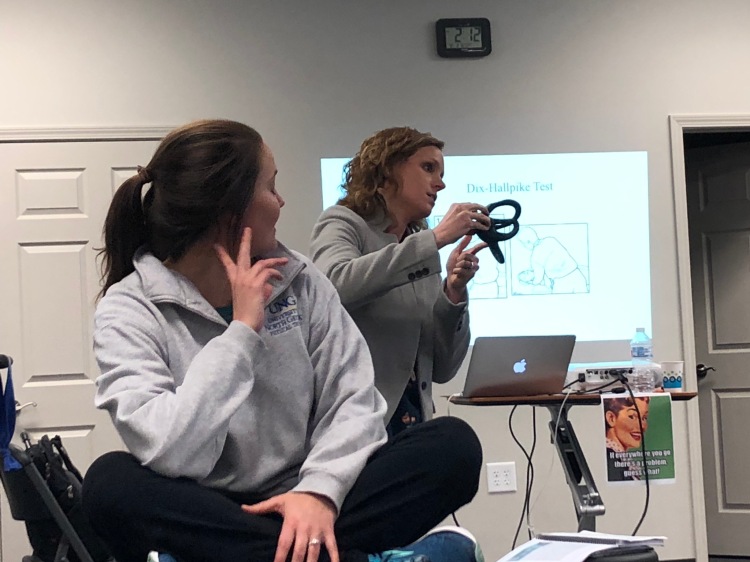The term vertigo refers to the illusion of environmental motion, classically described as “spinning” or “whirling.” The sense of motion is usually rotatory—”like getting off a merry-go-round”—but it may be more linear—”the ground tilts up and down, like being on a boat at sea.” (Reilly B 1990). Vertigo is defined as the subjective perception of rotational or translational movement in the absence of an external stimulus (You et al 2019).
Generally speaking, vertigo reflects a dysfunction in the vestibular system. Among patients with vertigo, benign positional vertigo is most common and is diagnosed up to 42% of the time with vertiginous symptoms. It is a common clinical disorder characterized by brief recurrent spells of vertigo often brought about by certain head position changes as may occur with looking up, turning over in bed, or straightening up after bending over. Recently confirmed, vertiginous attacks by turning or laying down in bed together with dizziness <1 minute, are important questions and strongly related to BPPV (Lindell et al 2018).
Using the word “bed” and “spinning sensation” during symptoms description are a common finding in someone with BPPV. Historically speaking, this is not as common in a patient describing symptoms of Cervicogenic Dizziness. The lack of true vertigo as a symptom of Cervicogenic Dizziness goes back to Brandt & Bronstein’s work in 1996 and not in typical descriptors from Wrisley’s work in 2000.
L’Heureux-Lebeau et al 2014 differentiated patients having Cervicogenic Dizziness vs BPPV and showed differences in sensorimotor disturbances between the two groups. Patients with Cervicogenic Dizziness were found to have a sensation of drunkenness and lightheadedness. Patients with BPPV more frequently mentioned rotatory sensation, which is not typical of cervicogenic dizziness.
With this being said, it is interesting to note the findings of a more recent study by Thompson-Harvey & Hain in 2019. The authors formulated a 41-question survey to identify patient features distinguishing cervical vertigo from vestibular causes of vertigo and vestibular migraine. They found that twenty-seven (27%) of cervical vertigo subjects complained of vertigo – i.e. spinning sensations. This is contrary to the work of Brandt & L’Heureux-Lebeau, as well as most practicing clinicians in the vestibular field; including ourselves. 1 in 4 patients diagnosed with cervical vertigo had actual vertigo symptoms!
They found that twenty-seven (27%) of cervical vertigo subjects complained of vertigo – i.e. spinning sensations.1 in 4 patients diagnosed with cervical vertigo had actual vertigo symptoms!
Even though L’Heureux-Lebeau et al 2014 found that patients with Cervicogenic Dizziness were found to have a sensation of drunkenness and lightheadedness vs BPPV patients noting more rotatory sensations, if you dive into the paper, you will find that 32% (1 in 3!) patients with Cervicogenic Dizziness actually described their symptoms as rotatory sensation too!
1 in 3 (32%) of patients with Cervicogenic Dizziness described their symptoms as rotatory sensations!
Furthermore, Thompson-Harvey & Hain found that the frequency of symptoms elicited by “turning over in bed” was almost identical across groups (cervical vertigo, migraine and vestibular vertigo). As the authors denote, the symptoms endorsed by subjects with cervical vertigo overlap substantially with well-established vestibular disturbances and migraine.
Therefore, even though I would still suggest that true vertigo is not a common descriptor of Cervicogenic Dizziness, as a clinician, I definitely would not rule out this condition if a patient has this symptom. From the research indicated above that, to date, is the only studies comparing dizziness from cervical origin to peripheral origin, indicate between 1 in 3 to 1 in 4 of your patients will have rotatory sensations (i.e. vertigo).
I do feel this continues to demonstrate an overlap of symptoms and systems in very complex head on neck disorientation conditions. It also continues to demonstrate the the “vestibular clinician” should be able to effectively and confidently assess and treat the cervical spine.
You can learn more about the screening and treatment process of Cervicogenic Dizzinesss through Integrative Clinical Concepts, where the author and his wife, a Vestibular Specialist, teach a 2-day course. Pertinent to this blog post, the first day provides the most up-to-date evidence review from multiple disciplines to diagnose through the “Optimal Sequence Algorithm” to assist in ruling out disorders and ruling in cervical spine, including determining if single or double entity exists.
If you would like to host a course for your staff (either a vestibular, neuro, sports or ortho clinic), please do not hesitate to contact me at harrisonvaughanpt@gmail.com for prices and discounts.
Authors
Harrison N. Vaughan, PT, DPT, OCS, Dip. Osteopracic, FAAOMPT
Instructor: Cervicogenic Dizziness for Integrative Clinical Concepts
Danielle N. Vaughan, PT, DPT, Vestibular Specialist
Instructor: Cervicogenic Dizziness for Integrative Clinical Concepts
Want to learn in person? Attend a #manualtherapyparty! Check out our course calendar below!
Learn more online - new online discussion group included!
Want an approach that enhances your existing evaluation and treatment? No commercial model gives you THE answer. You need an approach that blends the modern with the old school.
Keeping it Eclectic...- NEW - Online Discussion Group
- Live cases
- webinars
- lecture
- Live Q&A
- over 600 videos - hundreds of techniques and more!
- Check out MMT Insiders


















Post a Comment
Post a Comment